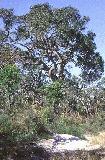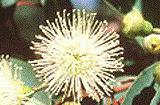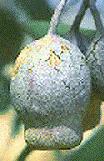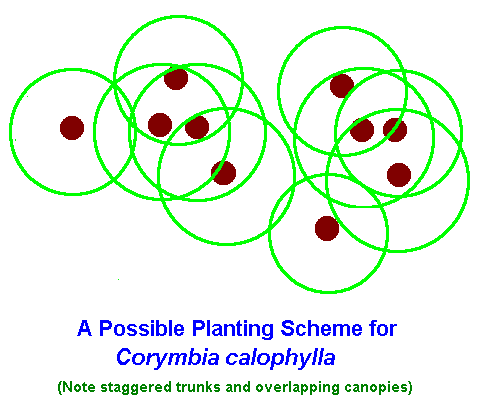|
[Front Page] [Features] [Departments] [SGAP Home Page] [Subscribe]

Coastal Sandplain and Heathland Plants of Western Australia
Marri; Corymbia calophylla
Nicholas Mansergh
For all you readers in the West, you will be so familiar with some of these plants, that they are often ignored or passed. For our readers elsewhere, my apologies, this IS another series of articles extolling the virtues and beauty of Western Australia's coastal sand-plain and heath-land plants! It's not my fault, I was compelled by the "Will of Heaven", and who could argue with such higher powers?? And besides, there are little tidbits that you may certainly apply (and should!) with your own local species. As I write, it is late February/early March and Corymbia calophylla (formerly Eucalyptus calophylla) is flowering rampantly across the plains and in the Darling Ranges, east of Perth.
 |
Corymbia calophylla in its natural habitat in the southwest of Western Australia.
Select the thumbnail image or plant name for a higher resolution image (48k). Photo: Dr Steve Hopper
|
 |
The normal white-flowered form of Corymbia calophylla.
Select the thumbnail image or plant name for a higher resolution image (38k). Photo: Dr Steve Hopper
|
The "common" white form is beautiful and worthy of being grown in its own right. Mostly available through the nursery trade however, is C.calophylla var. 'Rosea', in various shades of pale to dusty pink. This "ex-eucalyptus" grows quite easily in most conditions except, not unexpectedly, humid tropic and sub-tropic regions and the semi-arid to arid regions. It is not fussy as to soil types, and requires as much water as falls in the southern Australian cities!
The seed germinates easily and is susceptible to the usual barrage of fungal invasions as are most Aussie native seedlings at the germination stage; the usual precautions of hygiene and care, if not a damn good fungicide, do the trick. It should be noted that C.calophylla is an 'annual shedder'. The previous year's seed is usually ready for collection around the same time as flowering in the current year, and certainly for a month or so after. The black seed is large, compared to many eucalypts; it is very easily separated from the reddish-brown chaff. Collecting a good handful of the 'gumnuts' (or konkynuts!) and leaving in a plastic container (without the lid!) should just about donate all the seed you need to tree your front garden, back
garden, the verge AND the neighbour's front garden and verge! I don't know how your neighbour will feel about you transplanting sets of trees into his or her front yard, but you could try to allay all their fears by stating firmly that they are not to worry, the seedlings you are planting are not eucalypts, they are corymbias and are different!! That should confuse them enough to let you proceed with your duties!
 |
The urn-shaped "gum nuts" of Corymbia calophylla.
Select the thumbnail image or highlighted phrase for a higher resolution image (26k). Photo: Dr Steve Hopper
|
One of the bonuses of C.calophylla is its resistance to Phytophthora cinnamomi, the dreaded "dieback" disease that plagues so many of our most beautiful plants. It is mildly frost tolerant and certainly tolerates extended dry periods if its feet have discovered the water table. The flowers are large and smell delightfully of honey. It has beautiful brown, tessellated bark (if you like that sort of thing, which I do!), and fabulously large glossy green leaves - it really has a lot going for it!
Commonly, and in my personal opinion, wrongly, they are planted singly as a specimen tree. However, in the 'bush', they are, far more often than not, found growing in clumps of five or more. In this manner, the trees are much smaller and, in flower, are breath-taking. Stands of
these clumps are understoried by heathland plants of verticordias, hypocalymmas, acacias, leschenaultias, hakeas, anigozanthos, dianellas, dryandras, etc etc. (None of these are in flower at the same time as C.calophylla, however - for their moments of glory we will have to wait for spring).
I wonder why many people don't try to recreate the bush as much as possible. Many Councils are especially "guilty" of this. There is many a front yard, a verge, a park, that could be made far more beautiful by recreating a bit of your local bushland using the species that are indigenous to the area. The following planting diagram shows roughly in plan view how C.calophylla might be planted (of course, this applies equally to many other, or even all, tree-type species!).

Underplant this with "hundreds" of the low heathland plants and five to ten middle story plants and voila!, a little bit of bush. This whole planting scheme, naturally, depends on the size of the area you are trying to plant. It can be downsized! The basic theory is called the pyramid theory:
| Smallest number of plants | Trees |
| More plants | The taller understory plants |
| Lots and lots of plants | The small heathland plants, the groundcovers, the perennials and the annuals |
I can highly recommend anyone seriously interested in "unconventionalizing" the conventional planting schemes so often seen, to take a walk in their local bit of bush armed for battle with a piece of paper and a pencil, and perhaps (if you have to be precise) a loooong tape measure. Square off 20m x 20m (50m x 50m, or whatever) and count the number of species (floral biodiversity) and the number of plants within a species….then plot them on your piece of paper. This should give you a good idea about how and where to start.
Naturally, none of this is new….....Edna Walling was a great proponent of the theory of copying nature. Even though she came into "natives" later in her career, the idea of copying nature to give the most restful "pictures" was one she carried with her always. And so should we! One tree in full flower might well look nice, but a grouping (natural, of course), underplanted with heathland plants is eyecatching and, quite frankly, moves me' heart!
On this cheery note, I leave you to walk up a bushland path and sniff a flower or two. Happy planting and recreating.
Thanks to Dr Steve Hopper (Kings Park & Botanic Gardens, Perth, Western Australia) and to the Australian National Botanic Gardens, Canberra for permission to reproduce the photographs used in this article.
Nicholas Mansergh, by his own admission, is a middle-aged "nutter", whose main concerns in life are plants, conservation, and gardening.

[Front Page] [Features] [Departments] [SGAP Home Page] [Subscribe]
Australian Plants online - June 1999
Association of Societies for Growing Australian Plants
|